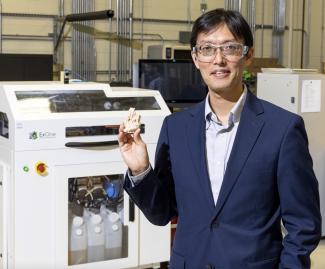|
INCITE program awards supercomputing time to 51 projects to advance open science |
The U.S. Department of Energy’s Office of Science announced allocations of supercomputer access to 51 high-impact computational science projects for 2022 through its Innovative and Novel Computational Impact on Theory and Experiment, or INCITE, program. These awards, which will pursue transformational advances in science and engineering, account for 60 percent of the available time on the leadership-class supercomputers at DOE’s Argonne and Oak Ridge National Laboratories. |
|
|
Polymer discovery gives 3D-printed sand super strength |
Researchers at the Department of Energy’s Oak Ridge National Laboratory designed a novel polymer to bind and strengthen silica sand for binder jet additive manufacturing, a 3D-printing method used by industries for prototyping and part production. The printable polymer enables sand structures with intricate geometries and exceptional strength – and is also water soluble. |

|
|
Scientists at ORNL employ digital esophagus to battle Barrett’s |
A team including researchers from the Department of Energy’s Oak Ridge National Laboratory has developed a digital tool to better monitor a condition known as Barrett’s esophagus, which affects more than 3 million people in the United States. Barrett’s occurs when the mucosal lining of the lower esophagus deteriorates, altering its cellular structure, and is most common in those with chronic acid reflux. |
|
|
Manufacturing – Carbon goes to space |
Oak Ridge National Laboratory researchers have developed a novel process to manufacture extreme heat resistant carbon-carbon composites at a faster rate. The performance of these materials will be tested in a U.S. Navy rocket that NASA will launch this fall. Made of graphite reinforced with carbon fiber, the composites use a pure graphite matrix instead of epoxy to bind the fibers. Researchers manufactured a nose cone and fins embedded with temperature sensors for the launch, which is designed to expose the material to the harsh environment of high-speed flight. |
|
|
Researchers reach quantum networking milestone in real-world environment |